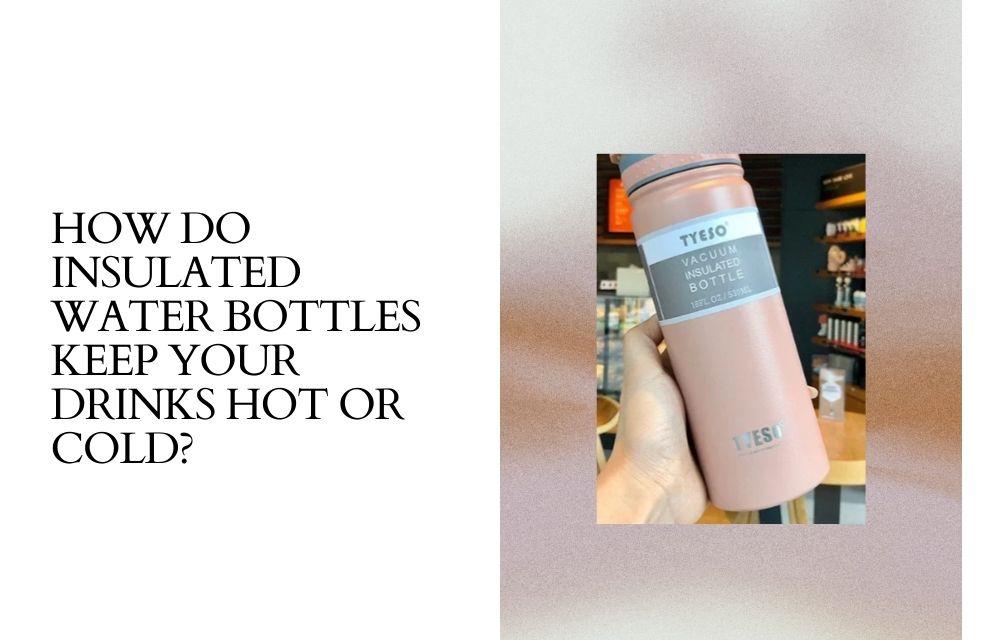How Do Insulated Water Bottles Keep Your Drinks Hot or Cold?

Having a water bottle that keeps your drinks hot or cold for extended periods is not just a convenience; it’s almost a necessity. Whether you’re a fitness enthusiast needing cold water throughout your workout, a busy professional who likes to sip hot coffee all morning, or someone who simply wants to ensure hydration throughout the day, insulated water bottles have become a popular choice. But how do these bottles manage to keep your beverages at the desired temperature for so long? In this blog, we will dive into the science behind insulated water bottles and explore why they are so effective.
Understanding the Design of Insulated Water Bottles
Insulated water bottles are designed using technology that helps maintain the temperature of the liquid inside, making them different from standard single-wall bottles. Here’s how they are structured:
The Role of Double Walls
Most insulated bottles are made with two layers of material—typically stainless steel—with a vacuum in between. This double-wall structure with a vacuum plays a crucial role in how insulated bottles prevent heat transfer.
What is a Vacuum Seal?
A vacuum seal between the two walls of the bottle means that there is a space with no air between the inner and outer layers. Since air is a conductor of heat, removing it means there’s less medium for heat to travel through, thereby slowing the rate of heat loss or gain.
How Heat Transfer Is Minimized
To understand why your drinks stay hot or cold, you need to understand the three methods of heat transfer: conduction, convection, and radiation. Insulated water bottles are designed to minimize all three.
Preventing Conduction
Conduction occurs when heat moves from a hotter object to a cooler one through direct contact. The vacuum in insulated bottles prevents conduction because there is no medium (like air) to facilitate the transfer of heat between the inner and outer walls.
Limiting Convection
Convection occurs in fluids (liquids or gases) where warmer parts of the fluid rise and cooler parts sink, creating a heat transfer loop. In the case of insulated bottles, the design minimizes the amount of air (or any fluid) inside that can move around, effectively limiting convection within the bottle.
Reducing Radiation
Radiation is the transfer of heat in the form of electromagnetic waves. The reflective surfaces inside the bottle reflect heat back inside, preventing it from escaping through radiation. This is particularly effective in keeping hot drinks warm.
The Benefits of Using Insulated Water Bottles
Using an insulated water bottle isn’t just about keeping your drink at the preferred temperature; there are several other benefits:
Environmental Impact
Reusable insulated bottles help reduce reliance on disposable plastic bottles, contributing to less waste and pollution. By choosing an insulated bottle, you’re making a more environmentally friendly choice.
Cost-Effectiveness
While the initial cost of purchasing an insulated water bottle might be higher than that of a regular bottle, the durability and effectiveness can save you money in the long run. Not having to buy beverages on the go because your drink remains at a desired temperature can also cut daily expenses.

Health and Safety
Insulated bottles made from food-grade stainless steel are safer for storing beverages as they don’t leach chemicals, unlike some plastics. Keeping drinks cold or hot for extended periods also helps inhibit the growth of bacteria.
Choosing the Right Insulated Water Bottle
When selecting an insulated water bottle, consider the following factors to find one that best suits your needs:
Bottle Size and Capacity
Choose a size that fits your hydration needs and is practical for your daily routine. If you exercise frequently or spend long hours outdoors, you might want a larger capacity bottle.
Type of Lid
The type of lid can affect insulation. Lids that screw on tend to be more effective at maintaining temperature than flip-top lids. Some lids come with features like locks or spouts for easy drinking without removing the lid.
Durability and Build Quality
Look for bottles that are made from high-quality materials and offer good build quality. Bottles with a powder-coated finish are often more resistant to scratches and wear.
Conclusion
Insulated water bottles are a smart choice for anyone looking to keep their beverages hot or cold for longer periods. Understanding the science behind how these bottles work can help you appreciate the technology and craftsmanship involved in their design. By choosing the right insulated water bottle, you not only ensure that your drink is at the perfect temperature but also contribute to environmental conservation and save money in the long run. Whether for daily use, travel, or outdoor adventures, an insulated water bottle can be your reliable companion, keeping you hydrated and happy no matter where you are.
For read more articles visit on ayema.
- Art
- Causes
- Crafts
- Dance
- Drinks
- Film
- Fitness
- Food
- Games
- Gardening
- Health
- Home
- Literature
- Music
- Networking
- Other
- Party
- Religion
- Shopping
- Sports
- Theater
- Wellness


